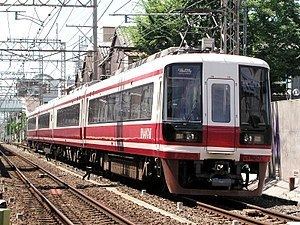Native name 高野線 Line length 64.5 km (40.1 mi) | ||
 | ||
Type Heavy railCommuter rail Terminis | ||
30000 cab view of nankai koya line
The Koya Line (高野線, Kōya sen) is a railway line in Osaka Prefecture and Wakayama Prefecture, Japan, owned and operated by the Nankai Electric Railway, a private railway operator. It connects Osaka and Koyasan, the capital of the Japanese Buddhist sect Shingon, via the suburbs of Osaka, such as Sakai, Osakasayama, Tondabayashi and Kawachinagano in Osaka Prefecture and Hashimoto and Kōya in Wakayama Prefecture. To distinguish it from other Nankai Lines, the Kōya Line is indicated with pictograms of coniferous-like trees which bring to mind Mount Koya, or with the line colour, green.
Contents
- 30000 cab view of nankai koya line
- Namba osaka to koyasan via wakayama nankai koya line
- Service patterns
- Namba Kishinosato Tamade Gokurakubashi
- Shiomibashi Kishinosato Tamade
- History
- References
For historical reasons, the line formally begins at Shiomibashi Station in Osaka and crosses the Nankai Main Line, the company's other main line, at Kishinosato-Tamade Station, though operationally it starts at Namba Station together with the Nankai Line, diverges at Kishinosato-Tamade Station and goes to Gokurakubashi Station, to connect to Koyasan through Nankai Cable Line.
The section from Shiomibashi to Kishinosato-Tamade, called the "Shiomibashi Line" (汐見橋線), has trains operating only in between those two stations. The section from Hashimoto to Gokurakubashi and the Koyasan Cable is named the "Koya Flower Railway" (こうや花鉄道) by operating a sightseeing train "Tenku".
Namba osaka to koyasan via wakayama nankai koya line
Service patterns
Namba - Kishinosato-Tamade - Gokurakubashi
Shiomibashi - Kishinosato-Tamade
The section is known as the Shiomibashi Line (汐見橋線).
History
The Takano Railway opened the Shiomibashi to Sayama section between 1898 and 1900, and extended the line to Kawachinagano in 1902. That section was electrified at 600 V DC in 1912. All further extensions were electrified when opened.
The Kawachinagano - Mikkaichicho section opened in 1914, and the line was extended to Hashimoto the following year. In 1922, the company merged with Nankai, and the Hashimoto to Gokurakubashi section opened in 1929.
Double-tracking of the line commenced in 1924, reaching Kawachinagano in 1938. The line voltage was increased to 1,500 V DC in 1973, and the following year, double-tracking reached Mikkaichicho, and Hashimoto in 1995.
